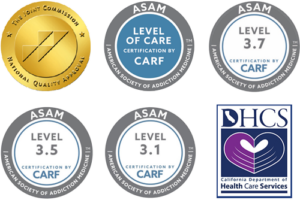How Much Fentanyl Does It Take To Overdose?
Published on: December 20, 2023 | Updated on: December 3, 2025
Fentanyl, a powerful synthetic opioid, is an extremely dangerous drug with a high risk of overdose. Understanding the dangers of fentanyl and recognizing the signs of overdose could help you save a life — including your own.
This guide teaches you about the risks associated with fentanyl use, its effects on the body, and how professional treatment can help you break out of addiction and start feeling like yourself again.
What Happens When You Overdose on Fentanyl?
A fentanyl overdose happens when the drug overwhelms the body’s systems, leading to potentially fatal consequences. As one of the strongest opioids in the world, Fentanyl can quickly depress the respiratory system, leading to breathing difficulties and, without immediate intervention, death.
How Long Does It Take To Overdose on Fentanyl?
The most dangerous effects of a fentanyl overdose often set in very fast. Even small amounts can cause an overdose in a matter of minutes, especially in individuals with no tolerance to opioids.
The Effects of Fentanyl on the Body
Fentanyl binds to opioid receptors in the brain, altering the perception of pain and often inducing a state of relaxation and euphoria. However, as mentioned above, the high also comes with a dangerous suppression of the respiratory system, which is the leading cause of overdose deaths.
In addition to respiratory depression, fentanyl significantly lowers blood pressure, reduces heart rate, and causes drowsiness, confusion, and dizziness. Regular use often leads to physical dependence and tolerance, meaning only higher doses provide the same high.
Long-term fentanyl use has its own set of risks, including gastrointestinal issues, a weakened immune system, and mental health disorders like depression and anxiety. That means that even if you avoid an overdose, fentanyl still wreaks havoc on your physical and mental health.
Fentanyl Overdose Statistics
Fentanyl overdose statistics paint a frightening picture of the opioid crisis gripping many parts of the world. These figures highlight the urgency with which this issue needs to be addressed.
- Rising Overdose Deaths: In recent years, the number of overdose deaths involving fentanyl has increased dramatically. The Centers for Disease Control and Prevention (CDC) reported that synthetic opioids like fentanyl were responsible for over 60% of opioid-related deaths in the United States in 2022.
- Demographic Impact: Fentanyl overdose rates vary across different age groups, genders, and ethnicities. Young adults (ages 25-44) are disproportionately affected, and while men are more likely to die from a fentanyl overdose, the rate of overdoses in women has risen in recent years.
- Geographical Variations: The prevalence of fentanyl overdose deaths varies geographically as well. Certain regions, particularly urban areas and some rural communities, saw a more pronounced increase in fentanyl-related deaths as the crisis unfolded.
- Comparison With Other Opioids: When compared to other opioids, fentanyl stands out for its potency — up to 50 times stronger than heroin and up to to 100 times stronger than morphine. This translates to a higher risk of overdose, even with a small amount, and contributes to the higher fatality rate associated with fentanyl compared to other opioids.
- Increase in Non-Prescription Fentanyl: Illegally manufactured fentanyl floods the drug market, often mixed with other drugs like heroin or cocaine. Illegal fentanyl production and sales led to a surge in unintentional overdoses; users may be unaware of the presence of fentanyl in drugs like cocaine and heroin.
- Hospitalization and Treatment: Hospitalizations due to fentanyl overdose have risen significantly over the last several years. These cases often require prolonged hospital stays and intensive medical intervention.
- Economic Impact: The surge in fentanyl-related overdoses also led to increased healthcare costs, loss of productivity, and strain on medical and social services.
Signs of Fentanyl Overdose
A fentanyl overdose is a medical emergency that requires immediate attention, and it’s important to know common fentanyl overdose symptoms to protect yourself and others.
During an overdose, someone might appear extremely confused, have difficulty speaking, or be unable to stay awake. Physical signs can include a pale face, clammy skin, and blue-tinged lips or fingernails.
As the overdose progresses, the person may experience seizures or muscle twitches, and their body may go limp. A critical sign is a noticeable change in breathing pattern — either shallow, erratic breathing, or no breathing at all. In severe cases, the person may go into a coma or suffer cardiac arrest, which is often fatal without prompt medical intervention. If you see these symptoms, get medical help as fast as possible.
Have Narcan on Hand
Narcan, also known as naloxone, is a medication used to counter the effects of opioid overdose, particularly in the case of an overdose caused by drugs like heroin, fentanyl, and prescription opioid medications. It works by rapidly binding to opioid receptors in the brain, which blocks or reverses the effects of the opioid, including extreme drowsiness, slowed breathing, or loss of consciousness.
Narcan is effective in treating an opioid overdose because it acts quickly, usually within minutes, to restore normal breathing in a person whose breathing has slowed or stopped as a result of overdosing with heroin or prescription opioid pain medications. It can be administered via injection or as a nasal spray, making it accessible for emergency responders, healthcare providers, and even laypeople to use in a critical situation.
It’s important to note that Narcan is not a substitute for emergency medical care, and anyone who has received Narcan for an opioid overdose should still seek immediate medical attention. Additionally, Narcan only works if opioids are present in the system; it has no effect on overdoses caused by non-opioid drugs.
Fentanyl Overdose Amount: How Much Fentanyl Does It Take To Overdose?
How much fentanyl does it take to overdose? The answer is more complicated than you might think. There is no standard fentanyl overdose amount, as each person’s tolerance level varies for the drug. Anyone who uses the drug risks an overdose, and there isn’t a clear point at which a person is most likely to OD. Fentanyl is dangerous in any amount, and the amount of fentanyl to overdose varies from person to person.
The Importance of Finding Treatment
Seeking treatment for fentanyl addiction could save your life. Comprehensive treatment programs address both physical dependence and the psychological aspects of addiction, paving the way for recovery and reducing the risk of relapse.
If you need help escaping addiction to fentanyl, reach out to us at Journey Hillside in Los Angeles. We specialize in treating fentanyl addiction and can help you detox, heal, and avoid live a life free from addiction. To learn more and schedule treatment, contact us today.






